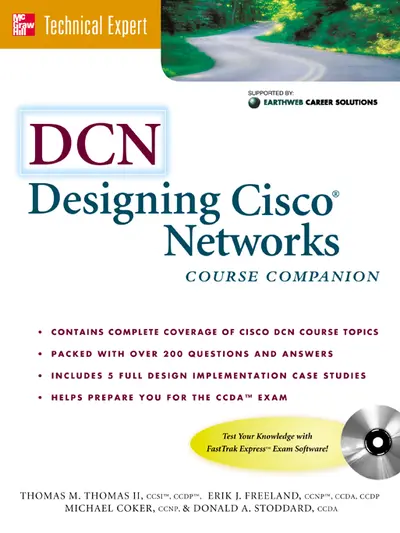My Account Details

ISBN10: 0072228644 | ISBN13: 9780072228649

ISBN10: 0072228644
ISBN13: 9780072228649
Chapter 1: Introduction to Designing Cisco Networks. Chapter 2: Internetworking Technology Overview. Chapter 3: Choosing Cisco Hardware and Software. Chapter 4: Cisco Design Fundamentals. Chapter 5: Documenting the Existing Network. Chapter 6: Documenting New Network. Chapter 7: Network Topology. Chapter 8: Local Area Network (LAN) Design. Chapter 9: Designing Wide-Area Networks (WANs). Chapter 10: Designing Network Addressing. Chapter 11: Designing Routing Architecture. Chapter 12: The Finishing Touches. Chapter 13: Proving the Design. Chapter 14: Testing the Design. Appendices.
Chapter 3: Choosing Cisco Hardware and Software. Chapter 4: Cisco Design Fundamentals. Chapter 5: Documenting the Existing Network. Chapter 6: Documenting New Network. Chapter 7: Network Topology. Chapter 8: Local Area Network (LAN) Design. Chapter 9: Designing Wide-Area Networks (WANs). Chapter 10: Designing Network Addressing. Chapter 11: Designing Routing Architecture. Chapter 12: The Finishing Touches. Chapter 13: Proving the Design. Chapter 14: Testing the Design. Appendices.
Chapter 5: Documenting the Existing Network. Chapter 6: Documenting New Network. Chapter 7: Network Topology. Chapter 8: Local Area Network (LAN) Design. Chapter 9: Designing Wide-Area Networks (WANs). Chapter 10: Designing Network Addressing. Chapter 11: Designing Routing Architecture. Chapter 12: The Finishing Touches. Chapter 13: Proving the Design. Chapter 14: Testing the Design. Appendices.
Chapter 7: Network Topology. Chapter 8: Local Area Network (LAN) Design. Chapter 9: Designing Wide-Area Networks (WANs). Chapter 10: Designing Network Addressing. Chapter 11: Designing Routing Architecture. Chapter 12: The Finishing Touches. Chapter 13: Proving the Design. Chapter 14: Testing the Design. Appendices.
Chapter 9: Designing Wide-Area Networks (WANs). Chapter 10: Designing Network Addressing. Chapter 11: Designing Routing Architecture. Chapter 12: The Finishing Touches. Chapter 13: Proving the Design. Chapter 14: Testing the Design. Appendices.
Chapter 11: Designing Routing Architecture. Chapter 12: The Finishing Touches. Chapter 13: Proving the Design. Chapter 14: Testing the Design. Appendices.
Chapter 13: Proving the Design. Chapter 14: Testing the Design. Appendices.
Appendices.
Need support? We're here to help - Get real-world support and resources every step of the way.
Top